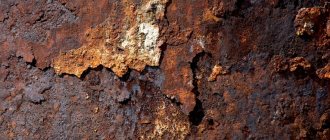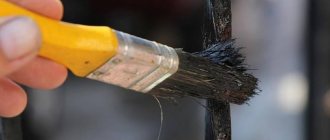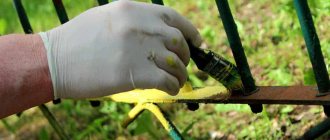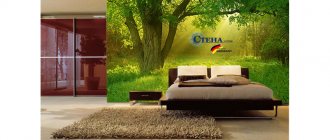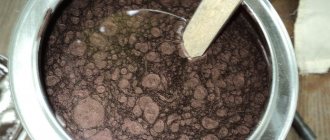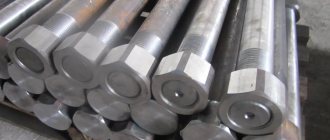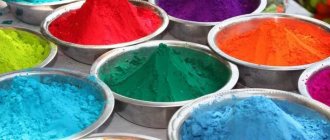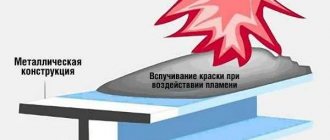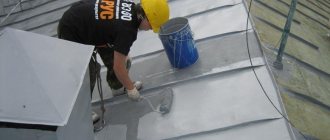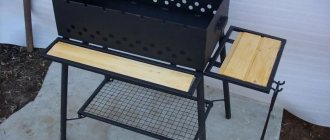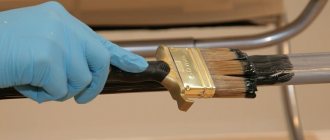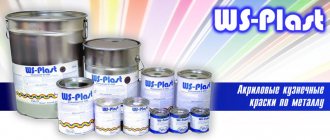To protect steel, two main types of coating are used – powder and polymer. They are applied to the metal after galvanizing. Polymer coating of steel is a liquid paint and varnish material that is applied by pouring/spraying paint onto the metal using special equipment. These include Professional RAL and RALplus coatings.
Powder coating of steel is also a polymer, but has a different chemical composition and is applied by spraying dry powder paint. It attaches to metal through electrostatic attraction, like a magnet. Through heat treatment, the powder is polymerized - transformed into a single uniform surface. Powder materials include: Steel silk, Steel velvet, Polyester, Ruukki, Polyurethane, Pural.
Features of the use of polymer paint
Polymer paint for metal is a composition that includes polymers, pigment substances, plasticizers and hardeners. Two types of paints are available, powder and liquid solutions; thinners are used to give them this state.
The first type is very different in its characteristics from liquid options. They do not dissolve under water. They do not have a specific smell, and their range of colors is huge. They are convenient to carry with you. They do not require the application of a primer before painting surfaces, and no harmful substances are released, so this is an environmentally friendly product. Although applying them requires special equipment.
Polymer paints have different compositions, because many paints contain polymers, including rubber paint. Polymer painting is widely used for metal structures, although it can also be used for other materials: concrete, wood, aluminum and others.
Polymer paint for metal is a composition that includes polymers, pigment substances, plasticizers and hardeners.
What is included in enamel
The product contains, as mentioned earlier, polymers; they serve to create a film on the surface. Hardeners and plasticizers, which are added to polymers, make it possible to create good adhesion to surfaces, as well as uniform coating of the product and reliable fixation of the coloring matter. Pigments are responsible for producing bright colors.
Pigments are responsible for producing bright colors.
Advantages and disadvantages of polymer paints
Polymer painting has a number of positive properties, although it has negative sides. The advantages include:
- Penetration into the smallest pores of products, this allows you to obtain a protective layer that reliably protects the entire surface from moisture and the formation of corrosive areas;
- High resistance to sunlight, so the color remains bright for a long time and does not fade;
- Resistant to mechanical shocks, as well as to chemical elements, the resulting layer is distinguished by its large thickness;
- Resistance to changes in temperature;
- Reasonable cost;
- Low consumption, usually one coat is sufficient;
- Universality of application, can be used for metal, wood, concrete, glass and other types of surfaces, but not in all cases. For example, they can be used to cover concrete floors, creating an abrasion-resistant and durable coating;
- Wide color range of paints;
- There are various types, you can choose the appropriate option for a specific task.
Manufacturers promise that if the dye is used correctly, the coating will last up to 50 years.
Penetration into the smallest pores of products allows you to obtain a protective layer.
Of course, polymer painting has a lot of advantages, but it also has its disadvantages:
- Difficulty removing the painted layer. No compositions have been invented that would allow this coloring agent to be washed off; therefore, removal is only possible using a mechanical method, which is difficult;
- You cannot paint surfaces with it yourself; special devices must be used for application; without them, the substance will be wasted just like that;
- In most cases, PVC paint can be used for metal; it is rarely used for other materials. A connection is created on the metal due to magnetic induction; it simply penetrates the surface, “dissolving” in it.
Special devices must be used for application.
Difference from regular paint
To obtain the finishing layer on a metal surface, liquid materials are mainly used, be it varnish, enamel or powder compositions. There is not much in common between the materials, and everything suggests that the future lies with powder materials:
- Liquid formulations must be diluted with solvents, which will subsequently evaporate. This forces an increase in energy consumption for heating the working surface and for ventilation. You can make a mistake with the viscosity indicator of the material, while powder formulations are supplied ready-made, and nothing additional needs to be done.
- Liquid products are consumed very uneconomically, since losses compared to powder reach up to 40%. Equipment for applying powder compositions has a recovery option, that is, the working process is practically waste-free.
- The coating itself of liquid enamel is not of the same quality as that provided by powder material. The film has high porosity and a strong degree of shrinkage. When using low-quality paint, drips and wrinkling are observed during drying. There are no such problems with polymer powders, since the coating has increased adhesion and increased strength to mechanical stress.
Technology of application of polymer coatings
The technology of working with polymer powder paint for metal involves the use of a special spray gun. The aerosol serves not only as a spray, but also as a means of charging the powder with electricity.
The spray tank has a positive charge, and the powder elements have a negative charge. This makes it possible to obtain magnetic induction when charges are connected, which provides the most reliable adhesion of the coloring matter to surfaces.
The technology of working with polymer powder paint for metal involves the use of a special spray gun.
Surface preparation
Any metal product must be prepared before painting. The following steps are carried out to obtain the required surface:
- Degreasing the product, any solvent is suitable;
- It is necessary to clean the welded elements from varnish and slag;
- The entire surface is cleaned of corrosive areas, as well as other types of contaminants. The object is coated with phosphates, which provide better hardness and protection against rust. If there was an old coating, it is removed.
It is better to work in a room where good ventilation is provided; the master should wear gloves and a mask.
The entire surface is cleaned of corrosive areas, as well as other types of contaminants.
Applying paint
Polymer painting of metal should be carried out in a special room where dust and dirt do not get into, good lighting is provided to see all unpainted areas. The product must be applied in one layer, for this reason they work slowly, covering the entire surface part by part. The next stage can be carried out immediately.
The product must be applied in one layer.
Polymerization
This process helps to obtain the necessary properties; polymerization involves heating the object in a special chamber. Typically the process lasts 60 minutes, temperatures in the chamber reach up to 200 degrees. The time and temperature indicators are influenced by the thickness of the layer.
In this case, it is necessary to take into account the rate of temperature increase, it affects the resulting effect. Because from this effect the coloring matter begins to be distributed throughout the product, filling its pores, it is better if the speed is low.
Typically the process lasts 60 minutes, temperatures in the chamber reach up to 200 degrees.
Final stage
Then they wait until the chamber naturally cools down to one hundred degrees. Do not open the cell door, otherwise cracks may appear on the object. After the oven has cooled to the required temperature, the item is removed from it and a new layer is applied.
It is permissible to paint up to three layers, the first is a primer, the second is a coloring layer, and the third is a varnish that adds gloss. It is usually applied to cars.
Painting up to three layers is acceptable.
Polymer paints give excellent results and are usually used for metal surfaces, but their scope is wider, because they are also suitable for other materials. The only thing is that such coloring cannot be done independently, due to the need for special equipment. This technology allows you to get a long-lasting result that will have a pleasant appearance.
Features of application. Equipment used
To apply the material, a polymer spray booth is required, since it is technically impossible to carry out work in a garage. The first stage includes the surface preparation process. It must be free of dirt and grease - brushes, sanding discs or chemicals are used for this. Next, you need to repair all the unevenness using putty, if any. Before applying the final coating, phosphating or chromating should be performed, depending on the metal. The layer protects the paint from destruction and peeling due to moisture.
Sometimes, before painting, treatment with sodium nitrate and chromium nitrate compounds is used - this substance resists the appearance of secondary corrosion. Next, a primer is applied to the surface, which will improve adhesion and provide additional protection against corrosion. Before placing the part in the painting booth, it must be dried and cooled. The powder is applied in the chamber using a pneumatic gun-manipulator. The most commonly used method is electrostatic spraying, in which charged particles fall on a grounded surface.
Polymerization is required in order for the powder to melt, which will lead to the creation of a protective film. Subsequently, this layer will go through a cooling and curing procedure.
Important. It is not recommended to carry out such work at home, since you will need to take a spray gun, oven, and insulating materials from the equipment. You also need a special uninterruptible power supply and a drying oven.
Advantages of powder paint from an economic point of view
Let's consider what are the positive aspects of coating a surface with powder paint in the economic field:
- Since there is practically no waste, it is economically profitable to buy it, because otherwise you will overpay for unused paint that has leaked, if we are talking about oil-based paint.
- Almost all powder paint is used for the material to be painted; as already mentioned, there is practically no loss.
- If there is a lot of paint, then it can be reused. We are talking about the coating that did not settle on the surface when the paint was sprayed. This is possible thanks to its successful composition.
- Moreover, the entire process is fully automated. Therefore, it doesn’t take long to learn how to paint correctly. Workers are usually ready to work within a few minutes of instruction.
- You can lose only one to four percent of paint when painting.
- At the same time, almost ninety-five percent of the paint that remains unused can be collected and reused. This means that powder paint has a high recycling rate.
- Since there is no need for a solvent, this can mean that you won't be breathing in the evaporating substance while waiting for it to dry, which also saves a lot of time and money.
Disadvantages of powder-based paint
Let us highlight the main five disadvantages that are typical for powder paint:
- Need a new container for each color. You can't use the same thing.
- An explosion is also possible, so you need to handle the can properly.
- It is very difficult to apply a thin layer of paint.
- If the temperature is low, it will be difficult to paint the surface.
- If the structure is non-standard or part of a prefabricated structure, then it will be difficult to use powder paint, since it is sprayed over a large surface area.
